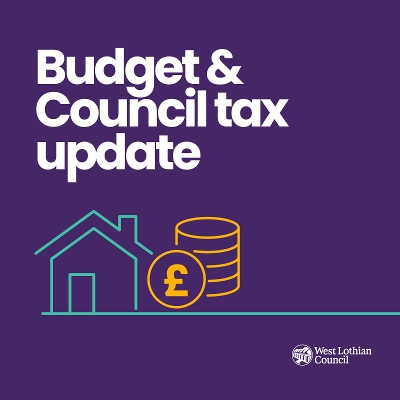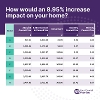Budget set to be approved
West Lothian Council is set to agree its budget for this year (2025/26) which would see almost £605 million spent on delivering day-to-day local services

Key highlights:
76% of this budget would be spent on these main areas:
• 37% of the budget is spent on Education in West Lothian
• 26% of the budget is spent on Social care and health services in West Lothian
• 13% is spent on Operational Services (roads, waste, open spaces etc)
Further investment comes from the council's capital and housing budgets which are agreed separately.
Council Tax
The Council had originally planned to increase Council Tax by 5.8% this year. However, it has now been confirmed by the Scottish Government that only 60% of NI contributions will be funded and passed down to councils, therefore an increase of 8.95% is proposed to meet the unavoidable cost associated with changes to employee's national insurance contributions, particularly for health and social care services.
The difference between 5.8% increase and an 8.95% increase is £3.2 million of funding being generated. This will cover the 40% shortfall in NI contributions and prevent a further £3 million of budget savings coming out of local services - and achieve a balanced budget - something the council is legally required to do.
For a Band D property, Council Tax would increase from £1,390.96 to £1,515.45 in 2025/26.
A 1% increase in Council Tax generates around an additional £1million of income for a council to spend on services.
Council Tax would have had to increase by over 13% last year (2024/25) to offset the savings that we had to make in order that we balanced our budget.
Given the levels of insufficient Government Grant funding, Council Tax would have to increase by 21% this year (2025/26) to offset the council's total budget gap - not the 8.95% increase which is being proposed. An 8.95% increase would still leave the council having to make £12 million of savings this year alone.
A total of 18% of West Lothian households are part of the Council Tax Reduction Scheme (CTRS) of which 14% receive a 100% reduction. The highest proportion of households receiving CTRS are in bands A and B where 78.8% of households receive CTRS. The Council Tax Reduction Scheme (CTRS) helps people on a low income pay all or part of their Council Tax.
The Council Tax collection rate is 98% in West Lothian.

Budget gap
Due to insufficient funding from the Scottish Government the council has a budget gap of £34.9 million over the next three years - with nearly £12 million of savings required this year alone (if a Council Tax rise of 8.95% is agreed) - this means that significant savings are required, as the council must legally set a balanced budget.
By 2028 the council will have had to make budget savings of over £207 million (between April 2007 - March 2028)
The Scottish Government's total core funding for this year is increasing by £29.5 million with half of that increase for Scottish Government directed priorities. This means that there is insufficient funding available to meet increasing demand for services, particularly for:
- social care for a growing number of elderly people
- adults and children with disabilities
- inflation which is significantly increasing the cost of providing services
Ringfenced funding restrictions
Additional Ring-fenced funding from the Scottish Government now almost amounts to the same level of movement in general core funding provided to the council for existing services. Ring-fenced funding is provided to councils for a specific purpose and must be spent on national policies.
The Accounts Commission refer to this as Scottish Government directed funding which limits local flexibility and discretion.
Core Grant Funding from the Scottish Government makes up the vast majority of the council's budget this year (81%). Council Tax makes up 19%.
Since 2015, the council has received a cash increase of £117.8milllion but £112.2 million of that has been provided for national spending and policy commitments (otherwise known as ring-fenced funding). Ringfenced funding must be spent on national policy commitments. The funding cannot be used for any other purpose.
However, over the last decade, which has seen a drastic and unprecedented level of increasing demand for services and increasing costs, the council has only received additional core revenue funding of £5.6milllion.
In the same time period, the council has had to deliver budget savings of £126 million (including 2025/26) to balance the budget in the same period. This demonstrates that funding has not been sufficient to cover the increased cost of delivering services.
Staff
The council has a no compulsory redundancy position, however the scale of the budget pressures facing the council will impact on staff numbers.
Overall the number of council staff is expected to increase by less than 10 employees to meet growing demand for services. Increases of staff are expected within Education and Operational Services
Changes to services
The majority of savings measures were agreed two years ago to be implemented over a five-year period, but more measures have had to be agreed in order to allow the Council to balance its budget - something we are legally required to do
All councils have a legal requirement to agree a balanced budget each year so if the funding provided is less than the cost of providing services overall, the council must reduce spending to balance its budget. A wide range of budget savings have already been agreed at last year's budget setting meeting and will be implemented further from April 2025.
Examples include:
- Internal savings through reviewing admin support and streamlining processes to reduce costs
- Internal management restructures
- Reduction in staff numbers in some areas, no-filling of vacancies and management restructures
- Review of existing contracts for commissioned services to achieve cost savings
- Intensive fostering campaign and development of a WL adoption services
- Support West Lothian Leisure to become fully self-funded
- Significant savings across Education which includes revised scheme of devolved school management
Over £2.1 million of additional savings are being proposed to help meet the increased funding gap have been approved for next year (2025/2026)
These include:
- Internal efficiency savings in staffing, property, supplies and services and transport budgets.
- Reduction in council tax empty property discounts in line with parameters set out in regulations
- Review of empty property relief and exemptions for Non-Domestic Rates
- Increased income from rent of council properties



